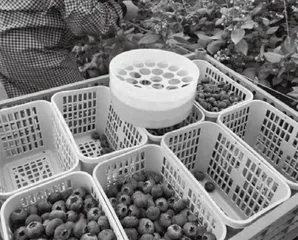Are Blueberries Really Blue? 蓝莓真是蓝色的吗?

The nutritional advice to “eat the rainbow” gets hard to follow once you reach the bottom half of the light spectrum. While red, yellow, and green foods are plentiful in nature, blue ingredients are much harder to come by. Even the most famously “blue” fruit in the produce aisle has a misleading name. As new research shared in the journal Science Advances explains, blueberries contain no blue pigments, which means they’re not blue in the true sense of the word.
“吃彩虹食物”这一营养建议不适用于位于光谱下半部分颜色的食物。虽然自然界中红色、黄色和绿色的食物丰富,但蓝色成分却很难获得。即使是农产品货架上人们耳熟能详的“蓝色”水果,其名字也容易让人误解。杂志《科学进展》上发表的一项新研究解释道:蓝莓不含蓝色色素,这意味着它们不是真正意义上的蓝色。
For their study, which was published on February 7, 2024, a team of scientists from Germany and the UK investigated the adaptations blueberries use to achieve their colorful appearance without pigmentation. The pigments of most fruits come through in their juices. That isn’t the case with blueberries, which suggested to the researchers that there was a rarer mechanism at play.
该研究于2024年2月7日发表,来自德国和英国的科学家团队研究了蓝莓在没有色素沉着的情况下为了其颜色呈现所做的适应性改变。大多数水果的色素都来自果汁,但蓝莓是个例外,这向研究人员表明,其中存在一种更罕见的机制。
They searched for the answer in the berry’s waxy coating. In addition to keeping it clean and protected, this outer layer is responsible for the fruit’s unique coloring. After studying the wax through an electron microscope, the scientists discovered nanostructures that scatter blue and ultraviolet light while absorbing all other wavelengths on the light spectrum. This produces something called “structural color”.
他们在浆果的蜡质外层中寻找答案。除了防污和起保护的作用,这一外层还与其独特的颜色有关。通过电子显微镜研究蜡质外层后,科学家发现了纳米结构,这些结构可以散射蓝光和紫外线光,同时吸收光谱中的其他波长的光,这产生了一种称为“结构色”的东西。
The team was also able to recreate the structures in a lab. After sampling the wax from the outside of the blueberry, they successfully recrystallized it and isolated the blue-scattering colorant, which is only two microns wide. The findings suggest that the colorant could be used to make new types of blue paints and dyes in the future.
研究团队也在实验室中再次制造了这些物质。在从蓝莓表皮提取蜡质样本后,他们成功地将其重新结晶,并分离出只有两微米宽的蓝色散射着色剂。研究结果表明,这种着色剂未来可用于制造新型蓝色涂料和染料。
“It was really interesting to find that there was an unknown coloration mechanism right under our noses, on popular fruits that we grow and eat all the time,” study co-author Rox Middleton, research fellow at the University of Bristol’s School of Biological Sciences, said in a press release.
这项研究的一位作者罗克斯·米德尔顿,布里斯托大学生物科学学院研究员在一份新闻稿中说:“在我们日常种植和食用的水果中发现一种未知的着色机制真的很有趣。”
The color blue is rare in the plant kingdom. It sits at the high-energy end of the light spectrum, so plants that rely on sunlight for nourishment can’t afford to reflect it away from them. They absorb the blue light instead while reflecting lower-energy wavelengths like reds and greens. This explains why there’s no true blue pigment in nature. Fruits and flowers that appear blue use various tricks, like mixing non-blue pigments, or in the blueberry’s case, relying on a special colorant in their coating.
蓝色在植物界中不常见。它位于光谱的高能端,因此依赖阳光生产营养物质的植物无法将蓝光反射出去。相反,它们会吸收蓝光,同时反射能量较低的波长,如红光和绿光。这就解释了自然界中没有真正的蓝色色素的原因。呈现蓝色的水果和花朵使用各种“技巧”,例如混合其他颜色的色素,或者像蓝莓一样,依靠其表皮中特殊的着色剂。
Word Bank
microscope /'maɪkrəskəʊp/ n. 显微镜
wavelength /'weɪvleŋθ/ n. 波长
recrystallize /riː'krɪstəlaɪz/ v. (使)再结晶
isolate /'aɪsəleɪt/ v. 使离析;(使)隔离,孤立